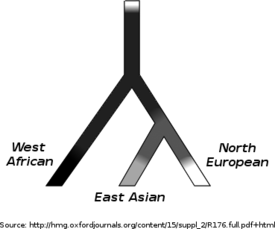Evolution of skin color

Loss of body hair in Hominini species is assumed to be related to the emergence of bipedalism some 5 to 7 million years ago. Bipedal hominin body hair may have disappeared gradually to allow better heat dissipation through sweating. The emergence of skin pigmentation dates to about 1.2 million years ago, under conditions of a megadrought that drove early humans into arid, open landscapes. Such conditions likely caused excess UV-B radiation. This favored the emergence of skin pigmentation in order to protect from folate depletion due to the increased exposure to sunlight. A theory that the pigmentation helped counter xeric stress by increasing the epidermal permeability barrier has been disproved.
With the evolution of hairless skin, abundant sweat glands, and skin rich in melanin, early humans could walk, run, and forage for food for long periods of time under the hot sun without brain damage due to overheating, giving them an evolutionary advantage over other species. By 1.2 million years ago, around the time of Homo ergaster, archaic humans (including the ancestors of Homo sapiens) had exactly the same receptor protein as modern sub-Saharan Africans.
This was the genotype inherited by anatomically modern humans, but retained only by part of the extant populations, thus forming an aspect of human genetic variation. About 100,000–70,000 years ago, some anatomically modern humans (Homo sapiens) began to migrate away from the tropics to the north where they were exposed to less intense sunlight. This was possibly in part due to the need for greater use of clothing to protect against the colder climate. Under these conditions there was less photodestruction of folate and so the evolutionary pressure working against the survival of lighter-skinned gene variants was reduced. In addition, lighter skin is able to generate more vitamin D (cholecalciferol) than darker skin, so it would have represented a health benefit in reduced sunlight if there were limited sources of vitamin D. Hence the leading hypothesis for the evolution of human skin color proposes that:
- From about 1.2 million years ago to less than 100,000 years ago, archaic humans, including archaic Homo sapiens, were dark-skinned.
- As Homo sapiens populations began to migrate, the evolutionary constraint keeping skin dark decreased proportionally to the distance north a population migrated, resulting in a range of skin tones within northern populations.
- At some point, some northern populations experienced positive selection for lighter skin due to the increased production of vitamin D from sunlight and the genes for darker skin disappeared from these populations.
- Subsequent migrations into different UV environments and admixture between populations have resulted in the varied range of skin pigmentations we see today.
The genetic mutations leading to light skin, though partially different among East Asians and Western Europeans, suggest the two groups experienced a similar selective pressure after settlement in northern latitudes.
The theory is partially supported by a study into the SLC24A5 gene which found that the allele associated with light skin in Europe "determined … that 18,000 years had passed since the light-skin allele was fixed in Europeans" but may have originated as recently as 12,000–6,000 years ago "given the imprecision of method" , which is in line with the earliest evidence of farming.
Research by Nina Jablonski suggests that an estimated time of about 10,000 to 20,000 years is enough for human populations to achieve optimal skin pigmentation in a particular geographic area but that development of ideal skin coloration may happen faster if the evolutionary pressure is stronger, even in as little as 100 generations. The length of time is also affected by cultural practices such as food intake, clothing, body coverings, and shelter usage which can alter the ways in which the environment affects populations.
One of the most recently proposed drivers of the evolution of skin pigmentation in humans is based on research that shows a superior barrier function in darkly pigmented skin. Most protective functions of the skin, including the permeability barrier and the antimicrobial barrier, reside in the stratum corneum (SC) and the researchers surmise that the SC has undergone the most genetic change since the loss of human body hair. Natural selection would have favored mutations that protect this essential barrier; one such protective adaptation is the pigmentation of interfollicular epidermis, because it improves barrier function as compared to non-pigmented skin. In lush rainforests, however, where UV-B radiation and xeric stress were not in excess, light pigmentation would not have been nearly as detrimental. This explains the side-by-side residence of lightly pigmented and darkly pigmented peoples.
Population and admixture studies suggest a three-way model for the evolution of human skin color, with dark skin evolving in early hominids in Africa and light skin evolving partly separately at least two times after modern humans had expanded out of Africa.
For the most part, the evolution of light skin has followed different genetic paths in Western and Eastern Eurasian populations. Two genes however, KITLG and ASIP, have mutations associated with lighter skin that have high frequencies in Eurasian populations and have estimated origin dates after humans spread out of Africa but before the divergence of the two lineages.
Comments
Post a Comment